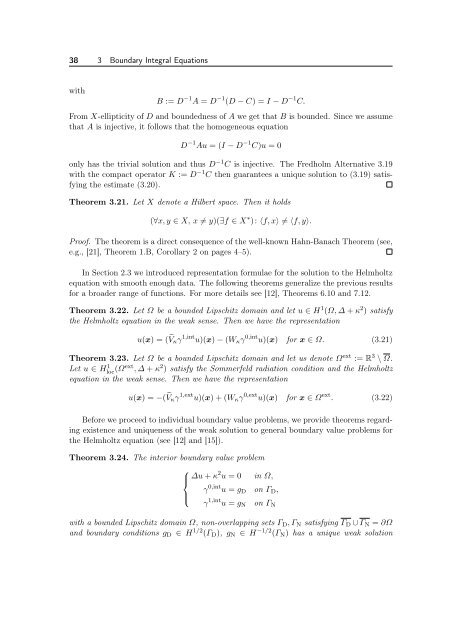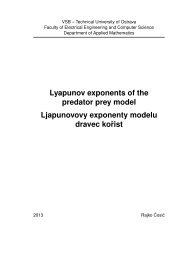The Boundary Element Method for the Helmholtz Equation ... - FEI VÅ B
The Boundary Element Method for the Helmholtz Equation ... - FEI VÅ B
The Boundary Element Method for the Helmholtz Equation ... - FEI VÅ B
You also want an ePaper? Increase the reach of your titles
YUMPU automatically turns print PDFs into web optimized ePapers that Google loves.
38 3 <strong>Boundary</strong> Integral <strong>Equation</strong>swithB := D −1 A = D −1 (D − C) = I − D −1 C.From X-ellipticity of D and boundedness of A we get that B is bounded. Since we assumethat A is injective, it follows that <strong>the</strong> homogeneous equationD −1 Au = (I − D −1 C)u = 0only has <strong>the</strong> trivial solution and thus D −1 C is injective. <strong>The</strong> Fredholm Alternative 3.19with <strong>the</strong> compact operator K := D −1 C <strong>the</strong>n guarantees a unique solution to (3.19) satisfying<strong>the</strong> estimate (3.20).<strong>The</strong>orem 3.21. Let X denote a Hilbert space. <strong>The</strong>n it holds(∀x, y ∈ X, x ≠ y)(∃f ∈ X ∗ ): ⟨f, x⟩ ≠ ⟨f, y⟩.Proof. <strong>The</strong> <strong>the</strong>orem is a direct consequence of <strong>the</strong> well-known Hahn-Banach <strong>The</strong>orem (see,e.g., [21], <strong>The</strong>orem 1.B, Corollary 2 on pages 4–5).In Section 2.3 we introduced representation <strong>for</strong>mulae <strong>for</strong> <strong>the</strong> solution to <strong>the</strong> <strong>Helmholtz</strong>equation with smooth enough data. <strong>The</strong> following <strong>the</strong>orems generalize <strong>the</strong> previous results<strong>for</strong> a broader range of functions. For more details see [12], <strong>The</strong>orems 6.10 and 7.12.<strong>The</strong>orem 3.22. Let Ω be a bounded Lipschitz domain and let u ∈ H 1 (Ω, ∆ + κ 2 ) satisfy<strong>the</strong> <strong>Helmholtz</strong> equation in <strong>the</strong> weak sense. <strong>The</strong>n we have <strong>the</strong> representationu(x) = ( V κ γ 1,int u)(x) − (W κ γ 0,int u)(x) <strong>for</strong> x ∈ Ω. (3.21)<strong>The</strong>orem 3.23. Let Ω be a bounded Lipschitz domain and let us denote Ω ext := R 3 \ Ω.Let u ∈ H 1 loc (Ωext , ∆ + κ 2 ) satisfy <strong>the</strong> Sommerfeld radiation condition and <strong>the</strong> <strong>Helmholtz</strong>equation in <strong>the</strong> weak sense. <strong>The</strong>n we have <strong>the</strong> representationu(x) = −( V κ γ 1,ext u)(x) + (W κ γ 0,ext u)(x) <strong>for</strong> x ∈ Ω ext . (3.22)Be<strong>for</strong>e we proceed to individual boundary value problems, we provide <strong>the</strong>orems regardingexistence and uniqueness of <strong>the</strong> weak solution to general boundary value problems <strong>for</strong><strong>the</strong> <strong>Helmholtz</strong> equation (see [12] and [15]).<strong>The</strong>orem 3.24. <strong>The</strong> interior boundary value problem⎧⎪⎨∆u + κ 2 u = 0 in Ω,γ 0,int u = g D on Γ D ,⎪⎩γ 1,int u = g N on Γ Nwith a bounded Lipschitz domain Ω, non-overlapping sets Γ D , Γ N satisfying Γ D ∪ Γ N = ∂Ωand boundary conditions g D ∈ H 1/2 (Γ D ), g N ∈ H −1/2 (Γ N ) has a unique weak solution









